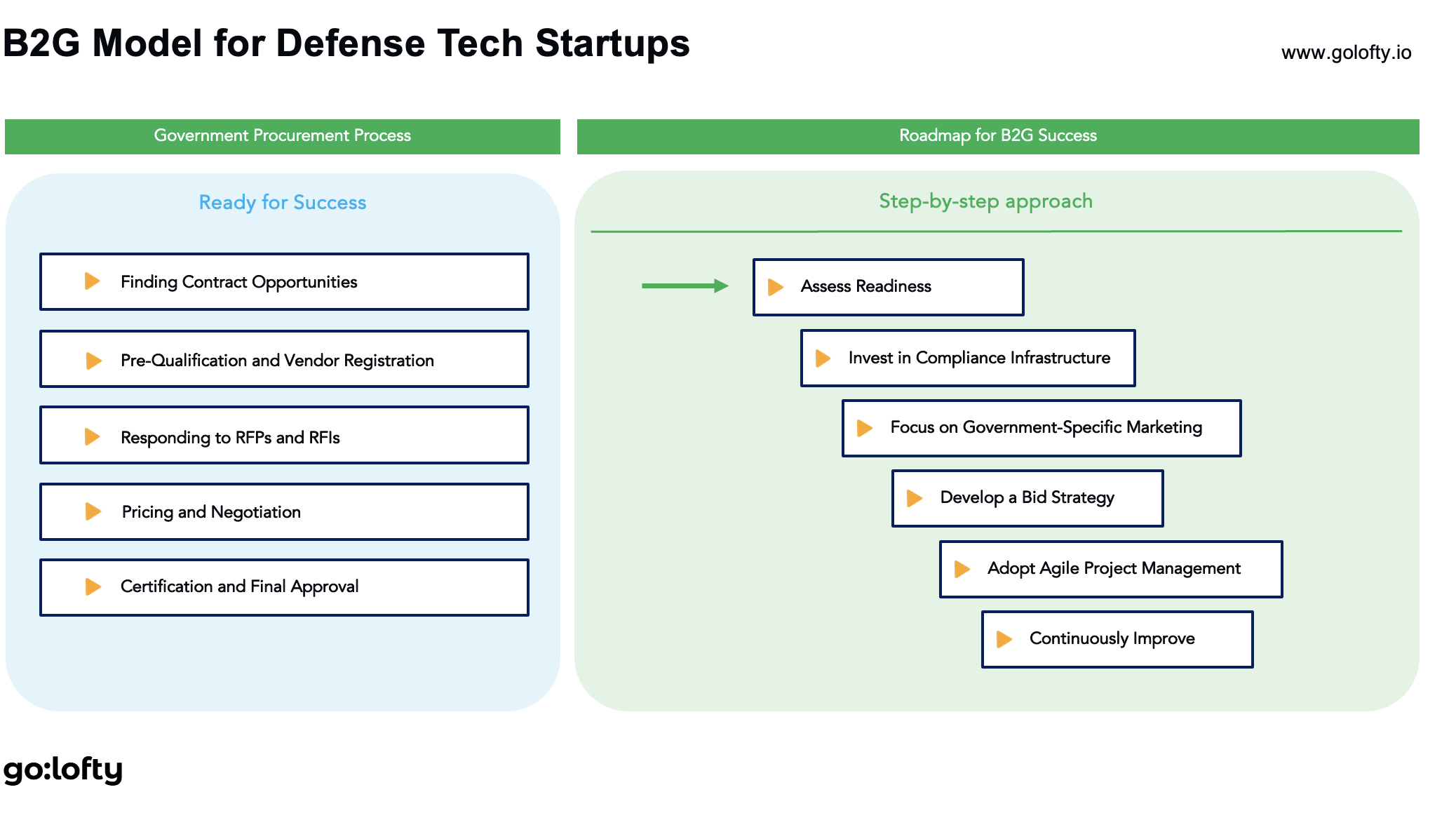How to Thrive in the B2G Model for Defense Tech: A Practical Roadmap.
For CEOs, C-level executives, early-stage B2B SaaS entrepreneurs, and consultants dipping their toes into the defense tech world, selling directly to government agencies—often called the Business-to-Government (B2G) model—can feel both thrilling and intimidating. On one hand, government clients represent a stable, well-funded source of revenue. On the other, they operate under stringent rules, long procurement cycles, and rigorous compliance standards. In short, it’s a different world than typical B2B or B2C markets.
If you’re a defense tech startup aiming to supply advanced solutions to the military or other government departments, understanding the B2G model isn’t just nice-to-have—it’s essential. Below, we’ll explore what sets B2G apart, how to navigate procurement and compliance, and the key strategies that can help you stand out. By the end, you’ll have a roadmap for turning government contracting from a daunting challenge into a strategic advantage.
Why Focus on B2G in Defense Tech?
The defense tech ecosystem thrives on innovation that aligns with national security priorities. Governments are steady customers, continually investing in new technologies—like advanced cybersecurity tools, autonomous systems, or AI-driven analytics—to maintain a strategic edge. This means the market can be less volatile than commercial tech sectors, offering long-term contracts and stable growth opportunities.
Of course, the flip side is complexity. Government agencies have strict rules, extensive vetting procedures, and often prefer working with trusted, proven vendors. Startups entering this arena must be ready to meet high security standards, adhere to export controls, and pass multiple compliance checks. Yet for those who rise to the challenge, these hurdles become barriers to entry that keep out less prepared competitors. Nail your compliance, demonstrate real value, and you can secure contracts that become a springboard for growth.
Building a Solid B2G Foundation
Before you even think about bidding on a contract, make sure your startup is ready:
Deep Customer Insight: Defense agencies don’t buy tech for novelty—they buy to solve pressing problems. Understand their mission priorities, whether that’s bolstering cybersecurity for satellites, improving drone reliability, or harnessing AI to analyze battlefield data. This requires continuous research and staying up-to-date with shifting defense policies and strategies.
Technological Readiness: Government tech buyers scrutinize products thoroughly. Expect rigorous testing for reliability, security, and scalability. Ensure your documentation is airtight, run your product through stress tests, and be prepared to articulate how you’ll handle edge cases or emergency scenarios.
Compliance Infrastructure: From ITAR and CMMC to ISO standards, compliance rules in defense tech aren’t negotiable. Put in place the frameworks to meet these standards early. Consider investing in specialized compliance officers or consultants to guide you. The better your compliance story, the more trust you earn before the sales pitch even begins.
Navigating Government Procurement: A Different Kind of Sales Cycle
Selling to government agencies means understanding their unique procurement process. This isn’t about quick demos and fast deals—it’s a marathon:
Identifying Opportunities: Government contract opportunities are often listed on public portals like SAM.gov in the U.S. Keep tabs on these platforms. Use filters to find solicitations relevant to your technology and niche.
Pre-Qualification and Registration: Most agencies require you to register as a vendor and prove financial stability, technical capabilities, and compliance credentials. This step weeds out unprepared applicants, so be thorough and precise with your paperwork.
Responding to RFPs and RFIs: When governments post Requests for Proposals (RFPs) or Requests for Information (RFIs), they want detailed answers. Craft responses that highlight how your solution addresses their specific needs. Include data, case studies (if you have them), and clear documentation of compliance. Avoid jargon—clarity is key.
Pricing and Negotiation: Government contracts often use fixed-price or cost-plus models. Be prepared to justify costs and negotiate terms that work for both parties. Remember, the lowest price may not win if you can prove long-term value, robust training, and superior maintenance support.
Certification and Final Approval: After you’re selected, more checks may follow. You might need to pass additional security screenings or environmental tests. Only when you’ve met all final conditions do you get the green light—and the contract signature.
Meeting Rigorous Regulatory Standards
For defense customers, risk is not an option. Compliance with regulations is the currency of trust:
Data Security and Privacy: Military-grade data protection is a must. Prove your cybersecurity chops. For instance, compliance with CMMC tells agencies you’re serious about safeguarding Controlled Unclassified Information (CUI).
Export Controls: If your product involves advanced tech or dual-use items, you’ll likely need to navigate ITAR or EAR rules. Understand these regulations inside and out to avoid painful fines or contract losses.
Performance Validation: Expect extensive testing. If you build a ruggedized drone, they’ll want to see it survive extreme conditions. If you offer cybersecurity software, they’ll ask for penetration testing reports. Embrace validation as a chance to prove your mettle.
Sustainability and Ethics: Increasingly, government agencies consider environmental and ethical standards. Demonstrating eco-friendly manufacturing processes or energy-efficient hardware can give you a competitive edge.
Stand-Out Strategies in a Competitive Market
In a crowded field, how do you distinguish your startup?
Relationship Building: Networking with government officials and defense contractors is invaluable. Attend industry events, conferences, and trade shows. Sometimes, an insightful conversation at a conference booth can open doors to mentorship, subcontracts, or direct introductions to procurement officers.
Thought Leadership: Publish white papers, contribute to defense forums, and speak on panels about emerging technologies. Show that you don’t just sell a product—you understand the landscape and can anticipate future needs. This builds credibility and turns you into a trusted advisor, not just a vendor.
Customer-Centric Approach: Learn the agency’s language. If you’re pitching to the Air Force, frame your solution in terms of mission readiness and reduced maintenance overhead. Show you’ve listened to their concerns and tailored your product to address them.
Transparency and Accountability: Government partners expect regular status reports, open communication, and accountability. If there’s a setback or delay, own it and explain how you’ll fix it. Honesty and proactive problem-solving can strengthen the relationship.
Anecdote from the Author:
I remember a time early in my career when I was advising a small cyber defense startup eager to land its first government contract. They had top-notch encryption tech—truly innovative stuff—but struggled to present it in a way that resonated with a particular agency’s concerns. By connecting with a retired procurement officer at a local defense summit, we gained insights on what that agency prioritized: robust training materials and clear maintenance procedures. Incorporating these elements into their proposal turned a lukewarm RFP response into a winning bid. The lesson was clear: technical brilliance is great, but aligning with the customer’s unique priorities can be the key to success.
Building Your B2G Roadmap
To confidently approach the government market, create a structured plan:
Assess Your Readiness: Audit your compliance frameworks, product maturity, and documentation. Identify gaps and address them before making first contact.
Target Specific Agencies: Don’t cast too wide a net. Identify a handful of agencies whose missions align closely with your solution. Focus your marketing and research on their needs.
Invest in Compliance Early: Hire experts to ensure you meet ITAR, CMMC, or other required standards. The sooner you tackle compliance, the faster you’ll clear initial hurdles.
Refine Your Proposal Process: Develop internal templates and best practices for responding to RFPs. Sharpen your messaging, highlight past performance (even if it’s from commercial pilots), and show you can handle scale.
Leverage Agility: Government projects can evolve over time. Use agile methods to adapt your product to changing requirements. Show that you’re not just a one-and-done supplier—you’re a partner who evolves with their needs.
Embracing the B2G Opportunity
The B2G model can feel complex, but with the right approach, it’s a gateway to stable, long-term success. By proving compliance, nurturing relationships, and demonstrating true mission alignment, your defense tech startup can become a valued contributor to national security.
If you’re looking for extra help crafting your B2G strategy, consider working with experts who know the terrain. At Go:lofty Consulting, we specialize in guiding defense tech startups through government procurement, compliance challenges, and sales strategies. Visit golofty.io to learn how we can support your journey. With the right roadmap, the B2G landscape transforms from a maze into a promising frontier for sustainable growth and meaningful impact.





